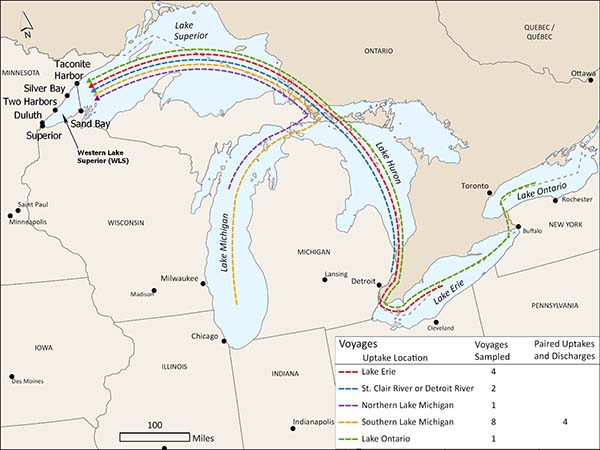The Great Waters Research Collaborative (GWRC), a project of the University of Wisconsin-Superior’s Lake Superior Research Institute (LSRI), released a study on nonindigenous species of plankton in ballast discharges from US and Canadian lakers to western Lake Superior. The study documented five species of non-indigenous zooplankton not yet established in western Lake Superior in laker ballast water discharged there.
Operators of the lakers proposed the study as a means of complying with Minnesota Pollution Control Agency ballast water permitting requirements, and approached GWRC to undertake the scientific research. The US Environmental Protection Agency paid for the study via the US Maritime Administration portion of the Great Lakes Restoration Initiative.
Ten US and Canadian-flag lakers participated in the study. Sampling took place in 2017, primarily in the late summer through early winter, and focused on ballast water discharges into western Lake Superior of water loaded from the lower four Great Lakes. GWRC also conducted “voyage-wide” sampling on a subset of voyages, documenting selected characteristics of the source water system and the associated ballast water uptake, plus ballast water discharge and the associated receiving system in western Lake Superior.
The overarching goal of the Project was to characterize aquatic organism densities and community composition in Great Lakes ships’ ballast water (uptake and discharge) and analyze target species presence/absence in selected source water and receiving ports. Specifically, the Project generated information on Great Lakes vessels’ ballast water regarding:
- Densities of a target organism, Hemimysis anomala, i.e., the “bloody red shrimp”, and other Great Lakes non-indigenous species in ballast uptake and discharge;
- Presence/absence of the H. anomala CO1 genetic marker in a subset of source and discharge ports and ballast uptake and discharge;
- Densities and community composition of planktonic organisms (i.e., zooplankton and protists) in ballast uptake and discharge;
- Water quality/chemistry of ballast uptake and discharge; and
- Densities of pathogen indicators Escherichia coli and Enterococcus spp. in ballast discharge.
Key takeaways
- In summary, this research found laker ballast water from the lower four Great Lakes that was destined to, or directly in, discharge to western Lake Superior ports, contained non-indigenous species of aquatic organisms not previously recorded in Lake Superior, and in one case, in the Great Lakes.
- In voyage-wide sampling events, evidence of Project-relevant non-indigenous species were found in the source harbors, the ballast uptake and ballast discharge.
- The Project detected these specimens though it surveyed only a fraction of the ship ballast water destined or discharged to western Lake Superior in 2017, only a small portion of the target ballast uptake/discharge events, and only snapshots in time of the shipping season.

Allegra Cangelosi, LSRI senior scientist, and principal investigator of the study, stated:
The chances that any of the organisms we detected in this study could survive, establish and harm Lake Superior are unknown, and may be negligible. The results nonetheless support greater research emphasis on identifying and validating performance of new ballast water management alternatives for lakers, as well as better understanding the risks of ballast-mediated transfers of organisms within the Great Lakes.
Commissioner John Linc Stine of the Minnesota Pollution Control Agency
This study is an important benchmark in protecting Lake Superior and inland waters from unwanted, aquatic species that are not native to the Great Lakes…Now it’s time to get to work with the vessel owners to develop additional ballast management strategies that further protect Minnesota waters.
Explore more by reading the full report:































































